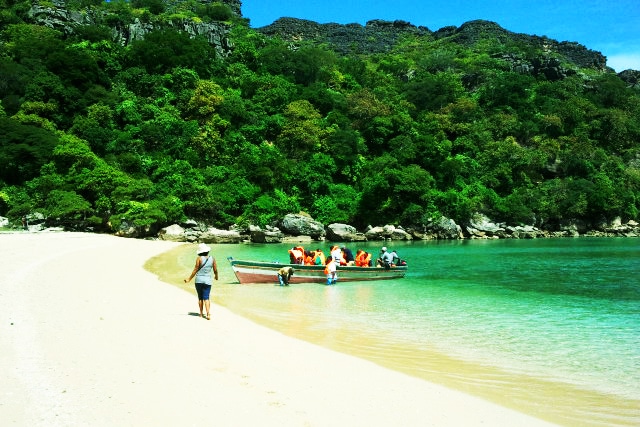Madagascar is home to stunning natural beauty. Tsingy Rouge Park provides an entrancing geological experience while Ranomafana National Park provides thermal spring therapy.
Nosy Be, Madagascar’s most beloved beach destination, features powdery yellow sands framed by swaying palms and resort hotels. Or discover its colonial history at Antananarivo’s rova (palace) and royal court rooms.
1. Masoala National Park
Masoala National Park is an idyllic tropical rainforest and coral reef destination, where stunning beaches meet wild lemurs and chameleons. As Madagascar’s largest remaining block of protected lowland forest, it shelters numerous endangered species like Red-Ruffed Lemurs and Aye-Ayes – not to mention mountainous rainforest reaching up towards towering peaks as well as deserted beaches in Antongil Bay where humpback whales come to breed and calve. The terrain here is richly varied – mountainous rainforest climb up towards towering peaks while deserted beaches in Antongil Bay where whales come to breed or calve.
The forest is a tropical oasis featuring towering palisander trees, vines, wild ginger plants and ferns; along with orchids. Additionally, lemur species like red-ruffed lemurs, white-fronted brown lemurs and northern bamboo lemurs live here, while there is an impressive collection of chameleon species including panther-hooded and stump-tailed types in abundance in the park.
Madagascar’s wildlife region with the greatest biodiversity and diversity is one of its richest wildlife habitats; new species continue to be discovered here every year. There is also an abundance of unique endemic wildlife species here such as Fanaloka and Falanouc lemurs as well as greater hedgehog tenrec and leaf-tailed gecko species.
Madagascar offers an incredible off-grid wilderness that provides an ideal place for relaxing and reconnecting with nature. Accessibility may be challenging however; to best reach it by plane from Maroantsetra then taking a 2- to 3-hour boat journey into the park from there.
This park consists of two marine and three terrestrial parks and covers an expansive area of beautiful rainforest. Here, visitors can enjoy kayaking on lakes or mangroves or snorkeling coral reefs while walking through verdant rainforest that is home to 10 lemur species among many other plant and animal life.
2. Ifaty
Ifaty offers stunning beach and one of the world’s most special habitats – making it the ideal coastal retreat after more active trekking or wildlife adventures. In its sleepy southern region lies some of Madagascar’s rarer species like Ring-tailed Lemurs and Verreaux’s Sifakas as well as an ideal place for spotting Ring-tailed Lemurs, Verreaux’s Sifakas, small private reserve which houses Pyxis Arachnoides Tortoises and Radiated Tortoises). In its lagoon dwell a variety of tropical fishes while during whale-watching months from mid June to September local fishermen use traditional pirogues to sail out and encounter migrating humpback whales up close and personal.
Ifaty offers many activities, but the highlight is undoubtedly visiting the “Avenue of Baobabs”, an avenue filled with ancient and impressively tall baobab trees. Other must-dos include trekking through Mikea Forest – home to many rare plant species – or staying overnight in Mangily village and sleeping aboard one of its traditional fisherman ‘pirogues’ for an unforgettable experience!
Since Ifaty offers comfortable weather from May to November, outdoor excursions during this period are best. Temperatures are mild yet still sunny, and rainfall and sunshine hours are at their lowest; making this period ideal for activities such as snorkelling and diving. Furthermore, Ifaty makes for an excellent base when visiting South West Madagascar’s unique spiny forests.
3. Lokobe National Park
Male Black lemurs, with almost completely black bodies and chestnut females with white tufts, are the reserve’s star attraction, but there is plenty more wildlife to be seen too – including Madagascar Pygmy Kingfishers, Long-Eared Owls and spectacular Panther Chameleons, in addition to locally endemic frogs and snakes.
Forests offer an ideal habitat for plant lovers with its diversity of beautiful trees and plants, such as palm species such as Ramy, local endemic species such as Tumble Grass, Rosewood and Vanilla Orchids – and much more.
Jean, your guide, knows his way around Lokobe and provides invaluable knowledge of Nosy Be’s flora and fauna. To begin the tour off right he may get you singing a Malagasy version of Old McDonald’s Farm before insisting upon silence in the park out of respect for its night-time wildlife and so that you may hear their calls.
Once at the reserve, take a walk through its thick rainforest to meet many diurnal and nocturnal animals while appreciating its beauty.
After your tour, you will return to Nosy Be and hop aboard a local charter boat for the ride back. Spend some time lounging around on the beach before enjoying lunch by the sea in Ampasipohy for some digestion relief and relaxation.
4. Ranomafana National Park
National park of Madagascar is an idyllic getaway for wildlife enthusiasts, boasting lemurs, birds, and other exotic fauna that visitors will adore. Additionally, this park provides the chance to learn about Madagascar’s abundant flora while also enjoying nature at its best!
It consists of lush rainforest interspersed by savannah, mountains and rugged cliffs – and is famously home to the critically endangered golden bamboo lemur (Daubentonia madagascariensis).
Visitors to the park can see more than just lemurs – they can spot 115 bird species such as the brown mesite and Pollen’s vanga that are found only here, including their endangered populations. Additionally, there are 62 types of reptiles such as snakes and fringed and satanic leaf-tailed geckos; newcomer botanists will find plenty to appreciate here too, such as orchids to exotic carnivorous plants!
Highlight of the park: night walk when the forest comes alive in an array of sounds. Fans of small mammals will delight in finding fanaloka, red mouse lemur or fossa – all easily visible here!
Day hikers usually complete the Vohiparara circuit within 2-3 days; its highest point offers breathtaking panoramic views from craggy mountain tops.
Ranomafana is best visited between April and December, when its dry climate allows visitors to spot animals; however, rainy months from July to September also present opportunities to spot wildlife; October and November are optimal times for this purpose. Numerous tour companies provide visits to Ranomafana; they typically involve travelling via road transport but it is possible to catch a train directly from Manakara if staying in Madagascar’s capital city of Manakara.
5. Ambohimanga
Ambohimanga stands as an iconic representation of Merina culture in Madagascar. A fortified palace that serves as burial grounds and places of worship, it also features burial plots which mark Madagascar’s history. Situated 21 kilometers north of Antananarivo’s capital city – Ambohimanga has maintained excellent physical condition to this day!
Madagascar’s landmarks are among its best-preserved, making this site an essential stop on any tourism itinerary to Madagascar. Dating back to 15th-century local nobility using it as royal residence, when Andriamasinavalona became King, expanding it with additional walls and trenches for protection during his rule – one ruler known for favoring promiscuous relationships which accounts for its many tombs dotted around this area.
His palace was also one of the oldest structures in the complex. Under Andriantsimitioviamninandrianadrazaka’s rule, however, expansion took place; 12 grandkids were given their own special house each.
Ambohimanga makes for a wonderful visit, featuring both an expansive public square and its original historic function: as the burial ground of African kings until 1897 when they were demolished by French troops.
Visitors to Isalo National Park while touring Madagascar must not miss it! This natural park boasts beautiful canyons and scenic vistas to be discovered through hiking trails through lush forests, as well as being an excellent place to spot lemurs – Madagascar’s iconic primates! Visitors to Isalo can also enjoy their picnic among magnificent sandstone rock formations in peace.

